MIS203 Assignment: Impacts of Driverless Vehicles Report
VerifiedAdded on 2022/09/18
|13
|3011
|24
Report
AI Summary
This report provides a detailed analysis of the impacts of driverless vehicles, also known as autonomous cars, on the car and trucking industries. It explores both the positive and negative consequences of this technology, including increased efficiency, reduced accidents, and potential job displacement. The report examines how driverless vehicles could transform the driving experience, improve traffic flow, and enhance safety. It also delves into the negative aspects, such as the potential for unemployment among drivers, ethical considerations, and cybersecurity risks. The report offers recommendations for managing the transition to driverless vehicles, including adopting standardized definitions, encouraging testing, addressing privacy concerns, and establishing industry working groups. The analysis considers various aspects like the impact on employment, ethical issues, and technological readiness, emphasizing the need for government and industry collaboration to navigate the challenges and opportunities presented by autonomous vehicle technology. The report concludes by highlighting the importance of proactive measures to ensure a smooth and beneficial integration of driverless vehicles into society.
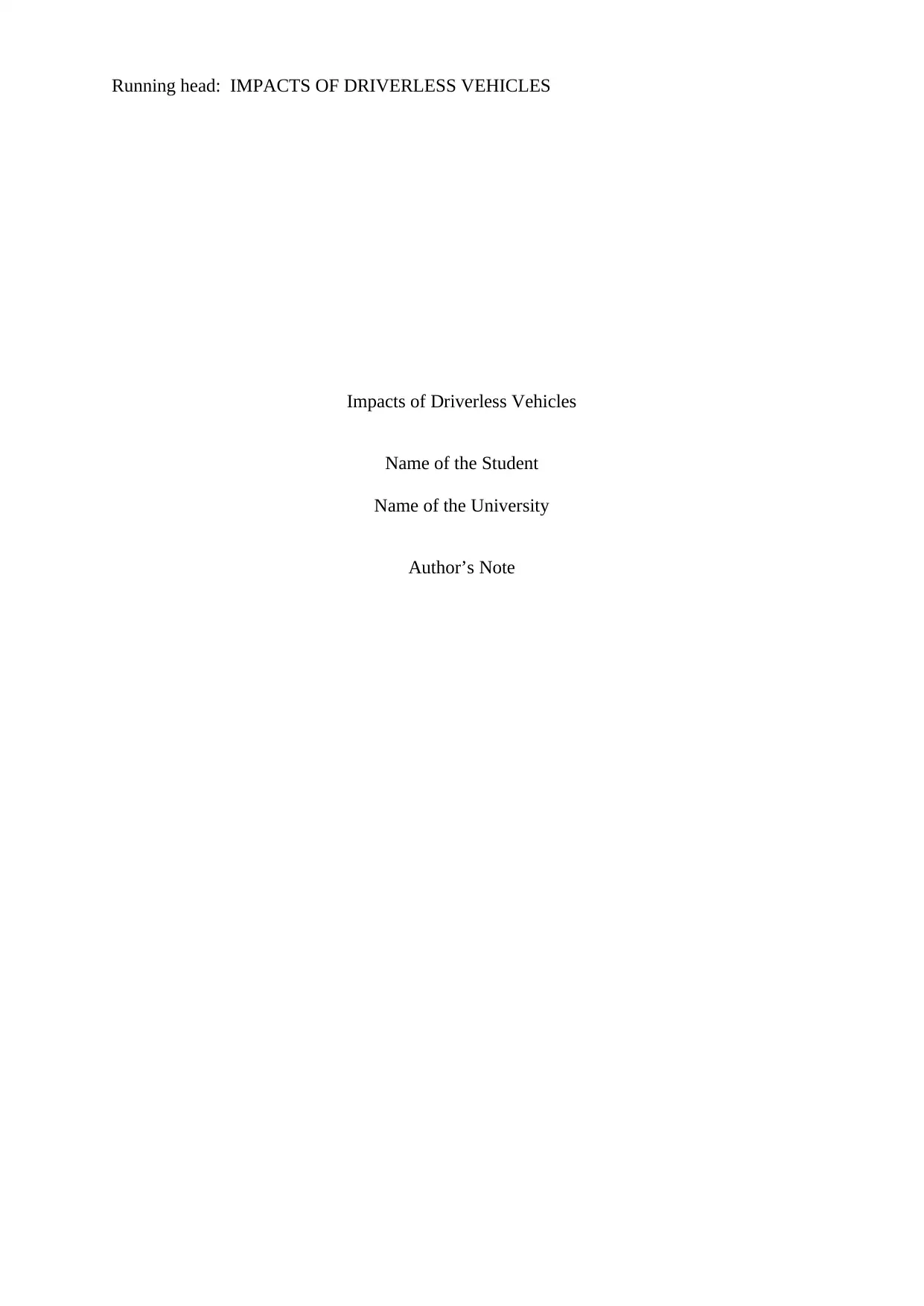
Running head: IMPACTS OF DRIVERLESS VEHICLES
Impacts of Driverless Vehicles
Name of the Student
Name of the University
Author’s Note
Impacts of Driverless Vehicles
Name of the Student
Name of the University
Author’s Note
Paraphrase This Document
Need a fresh take? Get an instant paraphrase of this document with our AI Paraphraser
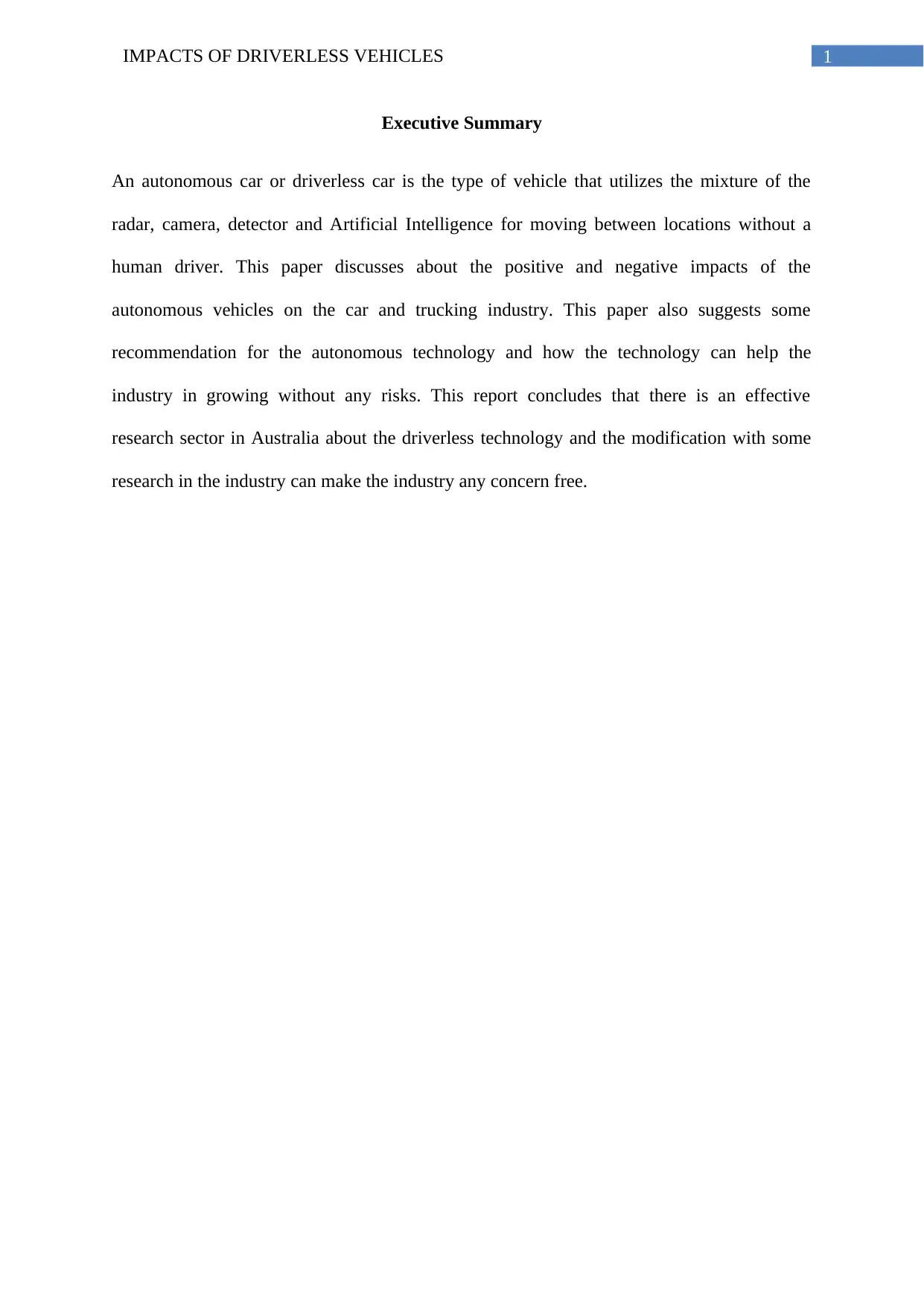
1IMPACTS OF DRIVERLESS VEHICLES
Executive Summary
An autonomous car or driverless car is the type of vehicle that utilizes the mixture of the
radar, camera, detector and Artificial Intelligence for moving between locations without a
human driver. This paper discusses about the positive and negative impacts of the
autonomous vehicles on the car and trucking industry. This paper also suggests some
recommendation for the autonomous technology and how the technology can help the
industry in growing without any risks. This report concludes that there is an effective
research sector in Australia about the driverless technology and the modification with some
research in the industry can make the industry any concern free.
Executive Summary
An autonomous car or driverless car is the type of vehicle that utilizes the mixture of the
radar, camera, detector and Artificial Intelligence for moving between locations without a
human driver. This paper discusses about the positive and negative impacts of the
autonomous vehicles on the car and trucking industry. This paper also suggests some
recommendation for the autonomous technology and how the technology can help the
industry in growing without any risks. This report concludes that there is an effective
research sector in Australia about the driverless technology and the modification with some
research in the industry can make the industry any concern free.
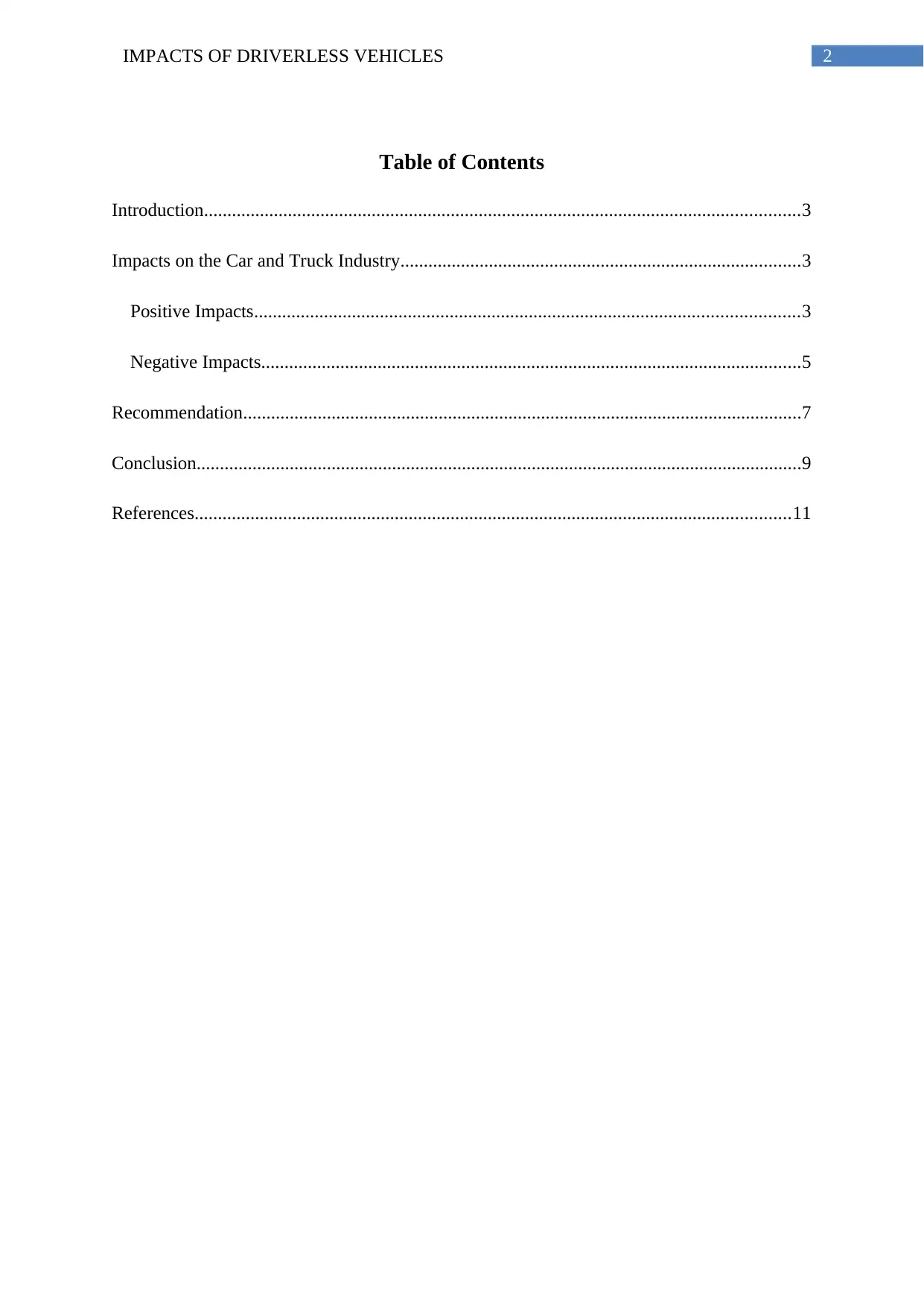
2IMPACTS OF DRIVERLESS VEHICLES
Table of Contents
Introduction................................................................................................................................3
Impacts on the Car and Truck Industry......................................................................................3
Positive Impacts.....................................................................................................................3
Negative Impacts....................................................................................................................5
Recommendation........................................................................................................................7
Conclusion..................................................................................................................................9
References................................................................................................................................11
Table of Contents
Introduction................................................................................................................................3
Impacts on the Car and Truck Industry......................................................................................3
Positive Impacts.....................................................................................................................3
Negative Impacts....................................................................................................................5
Recommendation........................................................................................................................7
Conclusion..................................................................................................................................9
References................................................................................................................................11
⊘ This is a preview!⊘
Do you want full access?
Subscribe today to unlock all pages.

Trusted by 1+ million students worldwide
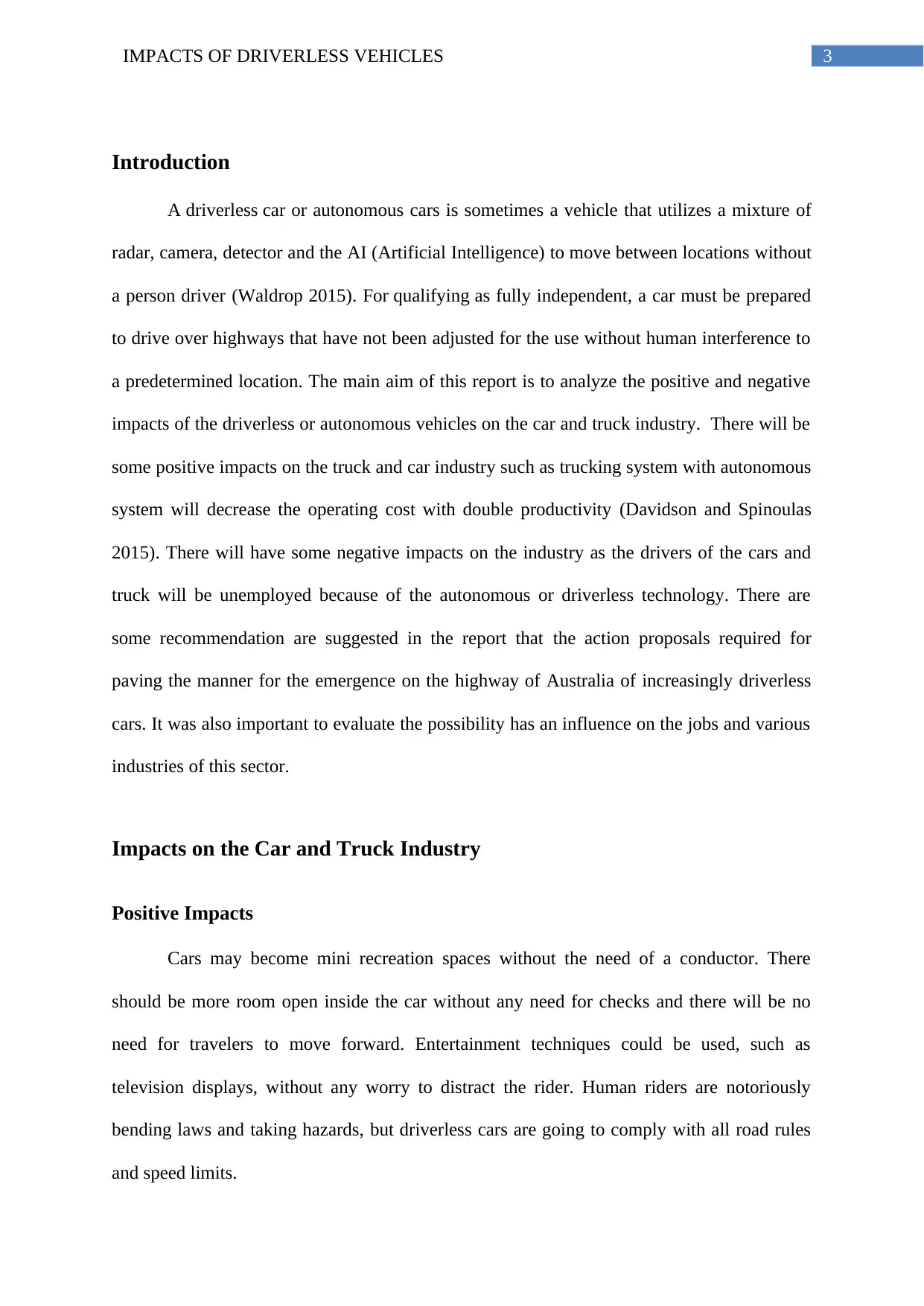
3IMPACTS OF DRIVERLESS VEHICLES
Introduction
A driverless car or autonomous cars is sometimes a vehicle that utilizes a mixture of
radar, camera, detector and the AI (Artificial Intelligence) to move between locations without
a person driver (Waldrop 2015). For qualifying as fully independent, a car must be prepared
to drive over highways that have not been adjusted for the use without human interference to
a predetermined location. The main aim of this report is to analyze the positive and negative
impacts of the driverless or autonomous vehicles on the car and truck industry. There will be
some positive impacts on the truck and car industry such as trucking system with autonomous
system will decrease the operating cost with double productivity (Davidson and Spinoulas
2015). There will have some negative impacts on the industry as the drivers of the cars and
truck will be unemployed because of the autonomous or driverless technology. There are
some recommendation are suggested in the report that the action proposals required for
paving the manner for the emergence on the highway of Australia of increasingly driverless
cars. It was also important to evaluate the possibility has an influence on the jobs and various
industries of this sector.
Impacts on the Car and Truck Industry
Positive Impacts
Cars may become mini recreation spaces without the need of a conductor. There
should be more room open inside the car without any need for checks and there will be no
need for travelers to move forward. Entertainment techniques could be used, such as
television displays, without any worry to distract the rider. Human riders are notoriously
bending laws and taking hazards, but driverless cars are going to comply with all road rules
and speed limits.
Introduction
A driverless car or autonomous cars is sometimes a vehicle that utilizes a mixture of
radar, camera, detector and the AI (Artificial Intelligence) to move between locations without
a person driver (Waldrop 2015). For qualifying as fully independent, a car must be prepared
to drive over highways that have not been adjusted for the use without human interference to
a predetermined location. The main aim of this report is to analyze the positive and negative
impacts of the driverless or autonomous vehicles on the car and truck industry. There will be
some positive impacts on the truck and car industry such as trucking system with autonomous
system will decrease the operating cost with double productivity (Davidson and Spinoulas
2015). There will have some negative impacts on the industry as the drivers of the cars and
truck will be unemployed because of the autonomous or driverless technology. There are
some recommendation are suggested in the report that the action proposals required for
paving the manner for the emergence on the highway of Australia of increasingly driverless
cars. It was also important to evaluate the possibility has an influence on the jobs and various
industries of this sector.
Impacts on the Car and Truck Industry
Positive Impacts
Cars may become mini recreation spaces without the need of a conductor. There
should be more room open inside the car without any need for checks and there will be no
need for travelers to move forward. Entertainment techniques could be used, such as
television displays, without any worry to distract the rider. Human riders are notoriously
bending laws and taking hazards, but driverless cars are going to comply with all road rules
and speed limits.
Paraphrase This Document
Need a fresh take? Get an instant paraphrase of this document with our AI Paraphraser
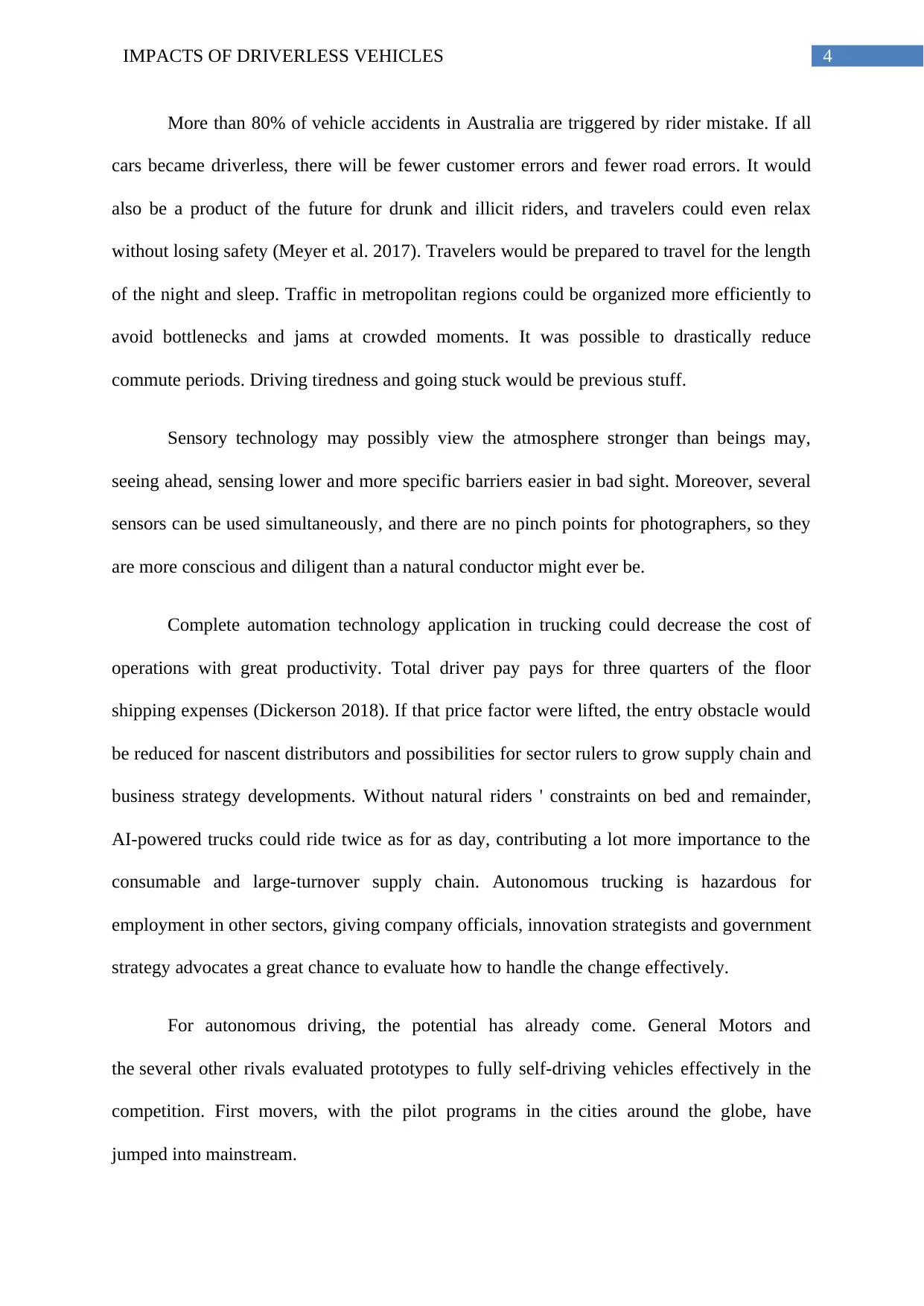
4IMPACTS OF DRIVERLESS VEHICLES
More than 80% of vehicle accidents in Australia are triggered by rider mistake. If all
cars became driverless, there will be fewer customer errors and fewer road errors. It would
also be a product of the future for drunk and illicit riders, and travelers could even relax
without losing safety (Meyer et al. 2017). Travelers would be prepared to travel for the length
of the night and sleep. Traffic in metropolitan regions could be organized more efficiently to
avoid bottlenecks and jams at crowded moments. It was possible to drastically reduce
commute periods. Driving tiredness and going stuck would be previous stuff.
Sensory technology may possibly view the atmosphere stronger than beings may,
seeing ahead, sensing lower and more specific barriers easier in bad sight. Moreover, several
sensors can be used simultaneously, and there are no pinch points for photographers, so they
are more conscious and diligent than a natural conductor might ever be.
Complete automation technology application in trucking could decrease the cost of
operations with great productivity. Total driver pay pays for three quarters of the floor
shipping expenses (Dickerson 2018). If that price factor were lifted, the entry obstacle would
be reduced for nascent distributors and possibilities for sector rulers to grow supply chain and
business strategy developments. Without natural riders ' constraints on bed and remainder,
AI-powered trucks could ride twice as for as day, contributing a lot more importance to the
consumable and large-turnover supply chain. Autonomous trucking is hazardous for
employment in other sectors, giving company officials, innovation strategists and government
strategy advocates a great chance to evaluate how to handle the change effectively.
For autonomous driving, the potential has already come. General Motors and
the several other rivals evaluated prototypes to fully self-driving vehicles effectively in the
competition. First movers, with the pilot programs in the cities around the globe, have
jumped into mainstream.
More than 80% of vehicle accidents in Australia are triggered by rider mistake. If all
cars became driverless, there will be fewer customer errors and fewer road errors. It would
also be a product of the future for drunk and illicit riders, and travelers could even relax
without losing safety (Meyer et al. 2017). Travelers would be prepared to travel for the length
of the night and sleep. Traffic in metropolitan regions could be organized more efficiently to
avoid bottlenecks and jams at crowded moments. It was possible to drastically reduce
commute periods. Driving tiredness and going stuck would be previous stuff.
Sensory technology may possibly view the atmosphere stronger than beings may,
seeing ahead, sensing lower and more specific barriers easier in bad sight. Moreover, several
sensors can be used simultaneously, and there are no pinch points for photographers, so they
are more conscious and diligent than a natural conductor might ever be.
Complete automation technology application in trucking could decrease the cost of
operations with great productivity. Total driver pay pays for three quarters of the floor
shipping expenses (Dickerson 2018). If that price factor were lifted, the entry obstacle would
be reduced for nascent distributors and possibilities for sector rulers to grow supply chain and
business strategy developments. Without natural riders ' constraints on bed and remainder,
AI-powered trucks could ride twice as for as day, contributing a lot more importance to the
consumable and large-turnover supply chain. Autonomous trucking is hazardous for
employment in other sectors, giving company officials, innovation strategists and government
strategy advocates a great chance to evaluate how to handle the change effectively.
For autonomous driving, the potential has already come. General Motors and
the several other rivals evaluated prototypes to fully self-driving vehicles effectively in the
competition. First movers, with the pilot programs in the cities around the globe, have
jumped into mainstream.
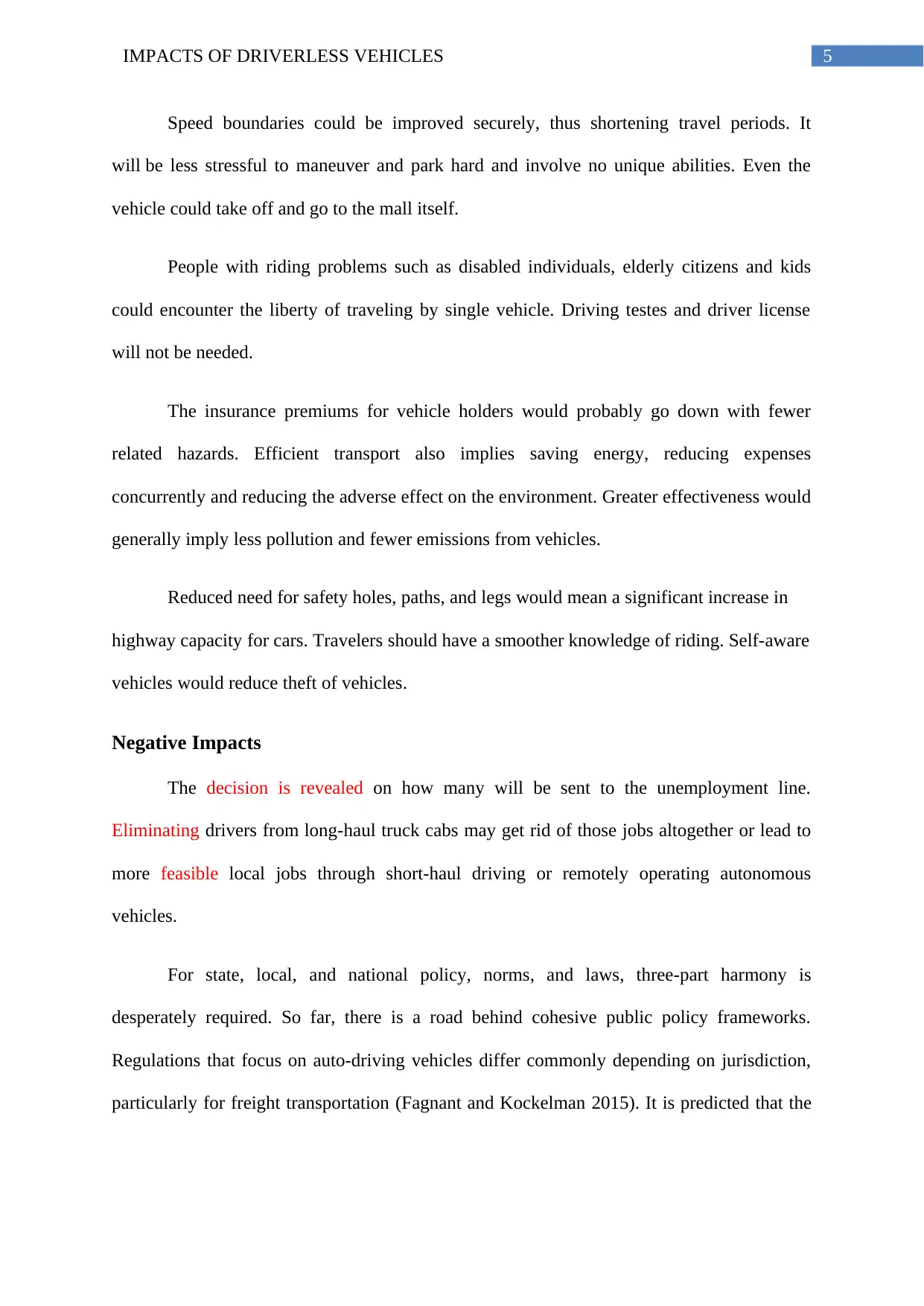
5IMPACTS OF DRIVERLESS VEHICLES
Speed boundaries could be improved securely, thus shortening travel periods. It
will be less stressful to maneuver and park hard and involve no unique abilities. Even the
vehicle could take off and go to the mall itself.
People with riding problems such as disabled individuals, elderly citizens and kids
could encounter the liberty of traveling by single vehicle. Driving testes and driver license
will not be needed.
The insurance premiums for vehicle holders would probably go down with fewer
related hazards. Efficient transport also implies saving energy, reducing expenses
concurrently and reducing the adverse effect on the environment. Greater effectiveness would
generally imply less pollution and fewer emissions from vehicles.
Reduced need for safety holes, paths, and legs would mean a significant increase in
highway capacity for cars. Travelers should have a smoother knowledge of riding. Self-aware
vehicles would reduce theft of vehicles.
Negative Impacts
The decision is revealed on how many will be sent to the unemployment line.
Eliminating drivers from long-haul truck cabs may get rid of those jobs altogether or lead to
more feasible local jobs through short-haul driving or remotely operating autonomous
vehicles.
For state, local, and national policy, norms, and laws, three-part harmony is
desperately required. So far, there is a road behind cohesive public policy frameworks.
Regulations that focus on auto-driving vehicles differ commonly depending on jurisdiction,
particularly for freight transportation (Fagnant and Kockelman 2015). It is predicted that the
Speed boundaries could be improved securely, thus shortening travel periods. It
will be less stressful to maneuver and park hard and involve no unique abilities. Even the
vehicle could take off and go to the mall itself.
People with riding problems such as disabled individuals, elderly citizens and kids
could encounter the liberty of traveling by single vehicle. Driving testes and driver license
will not be needed.
The insurance premiums for vehicle holders would probably go down with fewer
related hazards. Efficient transport also implies saving energy, reducing expenses
concurrently and reducing the adverse effect on the environment. Greater effectiveness would
generally imply less pollution and fewer emissions from vehicles.
Reduced need for safety holes, paths, and legs would mean a significant increase in
highway capacity for cars. Travelers should have a smoother knowledge of riding. Self-aware
vehicles would reduce theft of vehicles.
Negative Impacts
The decision is revealed on how many will be sent to the unemployment line.
Eliminating drivers from long-haul truck cabs may get rid of those jobs altogether or lead to
more feasible local jobs through short-haul driving or remotely operating autonomous
vehicles.
For state, local, and national policy, norms, and laws, three-part harmony is
desperately required. So far, there is a road behind cohesive public policy frameworks.
Regulations that focus on auto-driving vehicles differ commonly depending on jurisdiction,
particularly for freight transportation (Fagnant and Kockelman 2015). It is predicted that the
⊘ This is a preview!⊘
Do you want full access?
Subscribe today to unlock all pages.

Trusted by 1+ million students worldwide
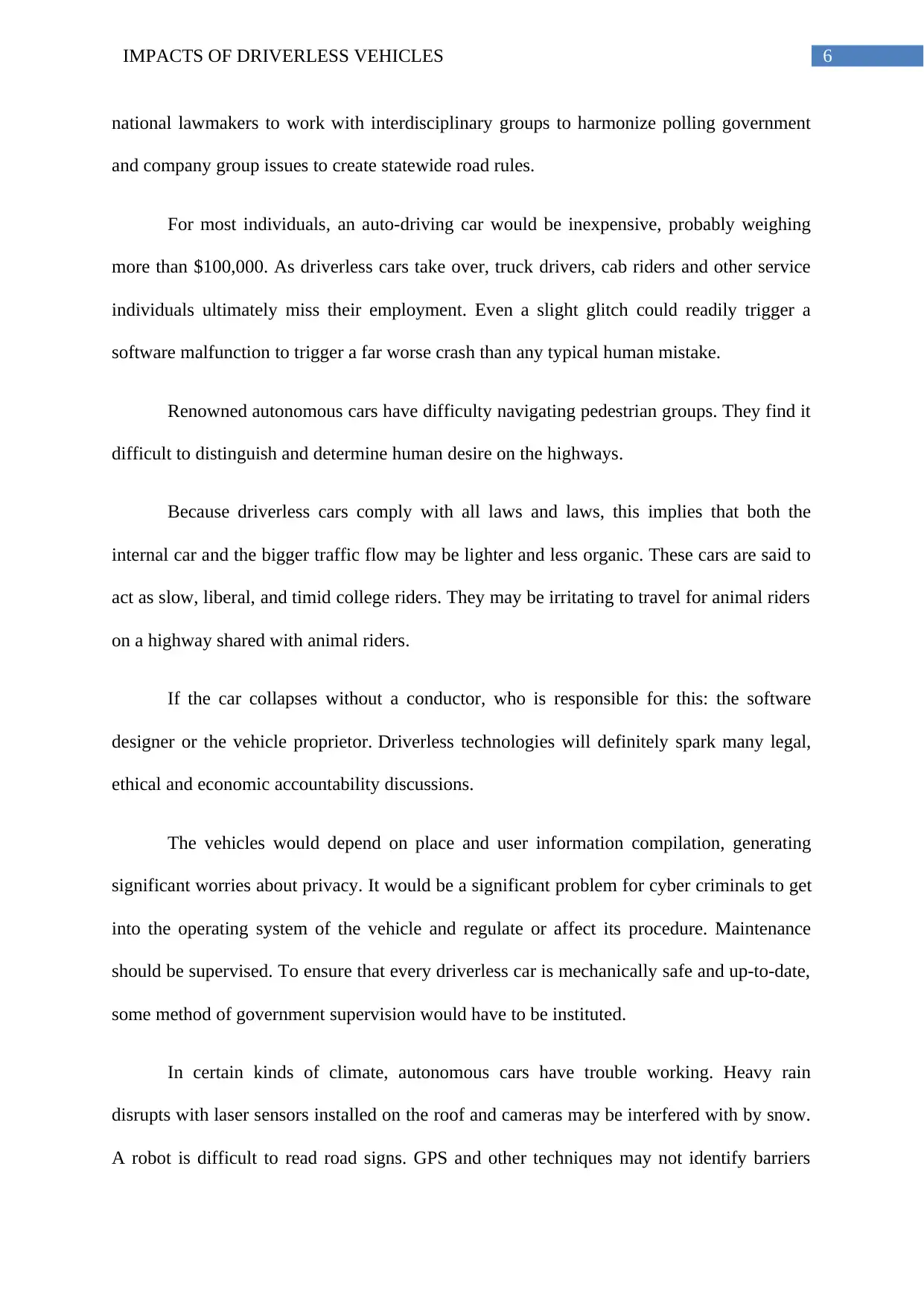
6IMPACTS OF DRIVERLESS VEHICLES
national lawmakers to work with interdisciplinary groups to harmonize polling government
and company group issues to create statewide road rules.
For most individuals, an auto-driving car would be inexpensive, probably weighing
more than $100,000. As driverless cars take over, truck drivers, cab riders and other service
individuals ultimately miss their employment. Even a slight glitch could readily trigger a
software malfunction to trigger a far worse crash than any typical human mistake.
Renowned autonomous cars have difficulty navigating pedestrian groups. They find it
difficult to distinguish and determine human desire on the highways.
Because driverless cars comply with all laws and laws, this implies that both the
internal car and the bigger traffic flow may be lighter and less organic. These cars are said to
act as slow, liberal, and timid college riders. They may be irritating to travel for animal riders
on a highway shared with animal riders.
If the car collapses without a conductor, who is responsible for this: the software
designer or the vehicle proprietor. Driverless technologies will definitely spark many legal,
ethical and economic accountability discussions.
The vehicles would depend on place and user information compilation, generating
significant worries about privacy. It would be a significant problem for cyber criminals to get
into the operating system of the vehicle and regulate or affect its procedure. Maintenance
should be supervised. To ensure that every driverless car is mechanically safe and up-to-date,
some method of government supervision would have to be instituted.
In certain kinds of climate, autonomous cars have trouble working. Heavy rain
disrupts with laser sensors installed on the roof and cameras may be interfered with by snow.
A robot is difficult to read road signs. GPS and other techniques may not identify barriers
national lawmakers to work with interdisciplinary groups to harmonize polling government
and company group issues to create statewide road rules.
For most individuals, an auto-driving car would be inexpensive, probably weighing
more than $100,000. As driverless cars take over, truck drivers, cab riders and other service
individuals ultimately miss their employment. Even a slight glitch could readily trigger a
software malfunction to trigger a far worse crash than any typical human mistake.
Renowned autonomous cars have difficulty navigating pedestrian groups. They find it
difficult to distinguish and determine human desire on the highways.
Because driverless cars comply with all laws and laws, this implies that both the
internal car and the bigger traffic flow may be lighter and less organic. These cars are said to
act as slow, liberal, and timid college riders. They may be irritating to travel for animal riders
on a highway shared with animal riders.
If the car collapses without a conductor, who is responsible for this: the software
designer or the vehicle proprietor. Driverless technologies will definitely spark many legal,
ethical and economic accountability discussions.
The vehicles would depend on place and user information compilation, generating
significant worries about privacy. It would be a significant problem for cyber criminals to get
into the operating system of the vehicle and regulate or affect its procedure. Maintenance
should be supervised. To ensure that every driverless car is mechanically safe and up-to-date,
some method of government supervision would have to be instituted.
In certain kinds of climate, autonomous cars have trouble working. Heavy rain
disrupts with laser sensors installed on the roof and cameras may be interfered with by snow.
A robot is difficult to read road signs. GPS and other techniques may not identify barriers
Paraphrase This Document
Need a fresh take? Get an instant paraphrase of this document with our AI Paraphraser
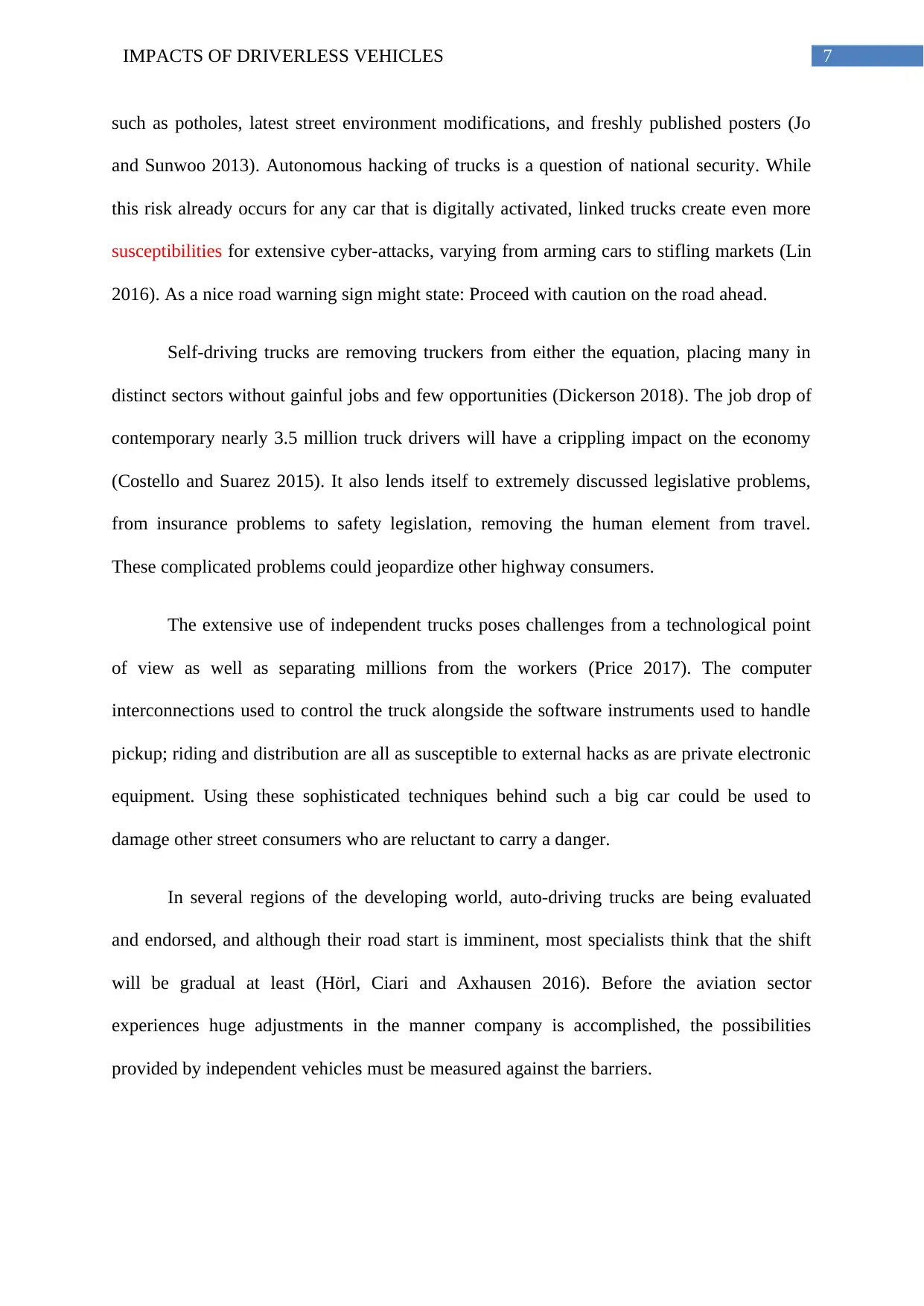
7IMPACTS OF DRIVERLESS VEHICLES
such as potholes, latest street environment modifications, and freshly published posters (Jo
and Sunwoo 2013). Autonomous hacking of trucks is a question of national security. While
this risk already occurs for any car that is digitally activated, linked trucks create even more
susceptibilities for extensive cyber-attacks, varying from arming cars to stifling markets (Lin
2016). As a nice road warning sign might state: Proceed with caution on the road ahead.
Self-driving trucks are removing truckers from either the equation, placing many in
distinct sectors without gainful jobs and few opportunities (Dickerson 2018). The job drop of
contemporary nearly 3.5 million truck drivers will have a crippling impact on the economy
(Costello and Suarez 2015). It also lends itself to extremely discussed legislative problems,
from insurance problems to safety legislation, removing the human element from travel.
These complicated problems could jeopardize other highway consumers.
The extensive use of independent trucks poses challenges from a technological point
of view as well as separating millions from the workers (Price 2017). The computer
interconnections used to control the truck alongside the software instruments used to handle
pickup; riding and distribution are all as susceptible to external hacks as are private electronic
equipment. Using these sophisticated techniques behind such a big car could be used to
damage other street consumers who are reluctant to carry a danger.
In several regions of the developing world, auto-driving trucks are being evaluated
and endorsed, and although their road start is imminent, most specialists think that the shift
will be gradual at least (Hörl, Ciari and Axhausen 2016). Before the aviation sector
experiences huge adjustments in the manner company is accomplished, the possibilities
provided by independent vehicles must be measured against the barriers.
such as potholes, latest street environment modifications, and freshly published posters (Jo
and Sunwoo 2013). Autonomous hacking of trucks is a question of national security. While
this risk already occurs for any car that is digitally activated, linked trucks create even more
susceptibilities for extensive cyber-attacks, varying from arming cars to stifling markets (Lin
2016). As a nice road warning sign might state: Proceed with caution on the road ahead.
Self-driving trucks are removing truckers from either the equation, placing many in
distinct sectors without gainful jobs and few opportunities (Dickerson 2018). The job drop of
contemporary nearly 3.5 million truck drivers will have a crippling impact on the economy
(Costello and Suarez 2015). It also lends itself to extremely discussed legislative problems,
from insurance problems to safety legislation, removing the human element from travel.
These complicated problems could jeopardize other highway consumers.
The extensive use of independent trucks poses challenges from a technological point
of view as well as separating millions from the workers (Price 2017). The computer
interconnections used to control the truck alongside the software instruments used to handle
pickup; riding and distribution are all as susceptible to external hacks as are private electronic
equipment. Using these sophisticated techniques behind such a big car could be used to
damage other street consumers who are reluctant to carry a danger.
In several regions of the developing world, auto-driving trucks are being evaluated
and endorsed, and although their road start is imminent, most specialists think that the shift
will be gradual at least (Hörl, Ciari and Axhausen 2016). Before the aviation sector
experiences huge adjustments in the manner company is accomplished, the possibilities
provided by independent vehicles must be measured against the barriers.
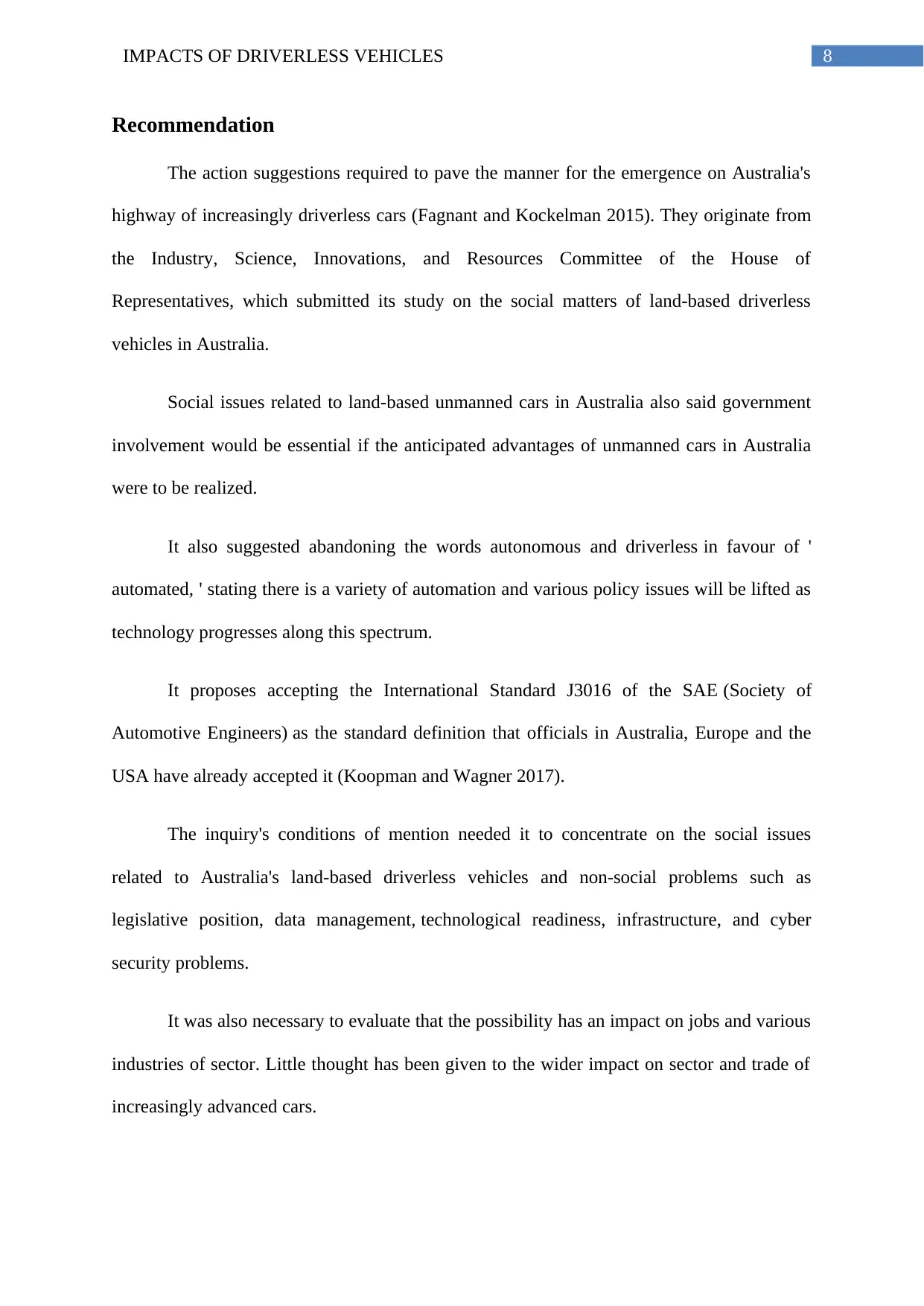
8IMPACTS OF DRIVERLESS VEHICLES
Recommendation
The action suggestions required to pave the manner for the emergence on Australia's
highway of increasingly driverless cars (Fagnant and Kockelman 2015). They originate from
the Industry, Science, Innovations, and Resources Committee of the House of
Representatives, which submitted its study on the social matters of land-based driverless
vehicles in Australia.
Social issues related to land-based unmanned cars in Australia also said government
involvement would be essential if the anticipated advantages of unmanned cars in Australia
were to be realized.
It also suggested abandoning the words autonomous and driverless in favour of '
automated, ' stating there is a variety of automation and various policy issues will be lifted as
technology progresses along this spectrum.
It proposes accepting the International Standard J3016 of the SAE (Society of
Automotive Engineers) as the standard definition that officials in Australia, Europe and the
USA have already accepted it (Koopman and Wagner 2017).
The inquiry's conditions of mention needed it to concentrate on the social issues
related to Australia's land-based driverless vehicles and non-social problems such as
legislative position, data management, technological readiness, infrastructure, and cyber
security problems.
It was also necessary to evaluate that the possibility has an impact on jobs and various
industries of sector. Little thought has been given to the wider impact on sector and trade of
increasingly advanced cars.
Recommendation
The action suggestions required to pave the manner for the emergence on Australia's
highway of increasingly driverless cars (Fagnant and Kockelman 2015). They originate from
the Industry, Science, Innovations, and Resources Committee of the House of
Representatives, which submitted its study on the social matters of land-based driverless
vehicles in Australia.
Social issues related to land-based unmanned cars in Australia also said government
involvement would be essential if the anticipated advantages of unmanned cars in Australia
were to be realized.
It also suggested abandoning the words autonomous and driverless in favour of '
automated, ' stating there is a variety of automation and various policy issues will be lifted as
technology progresses along this spectrum.
It proposes accepting the International Standard J3016 of the SAE (Society of
Automotive Engineers) as the standard definition that officials in Australia, Europe and the
USA have already accepted it (Koopman and Wagner 2017).
The inquiry's conditions of mention needed it to concentrate on the social issues
related to Australia's land-based driverless vehicles and non-social problems such as
legislative position, data management, technological readiness, infrastructure, and cyber
security problems.
It was also necessary to evaluate that the possibility has an impact on jobs and various
industries of sector. Little thought has been given to the wider impact on sector and trade of
increasingly advanced cars.
⊘ This is a preview!⊘
Do you want full access?
Subscribe today to unlock all pages.

Trusted by 1+ million students worldwide
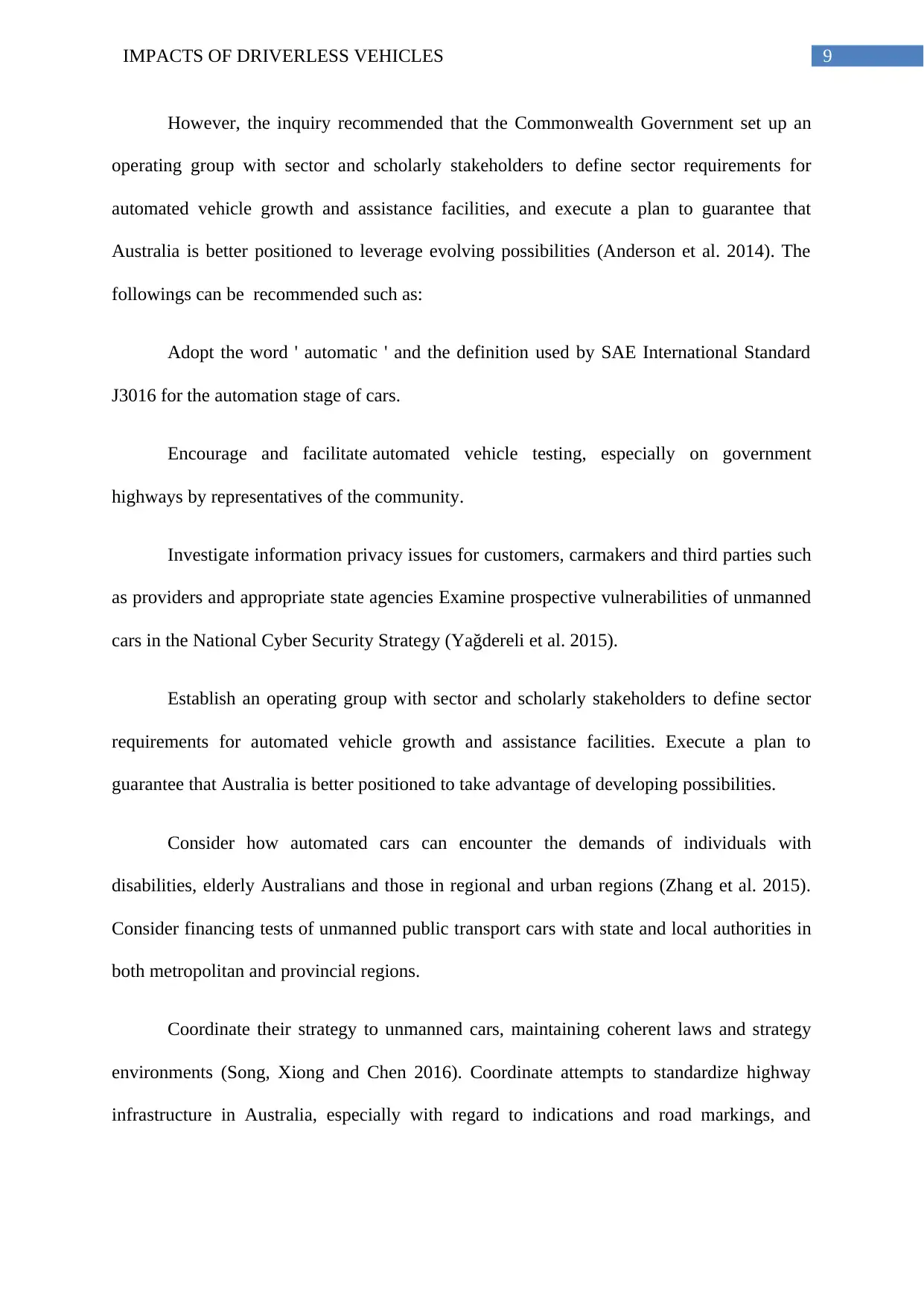
9IMPACTS OF DRIVERLESS VEHICLES
However, the inquiry recommended that the Commonwealth Government set up an
operating group with sector and scholarly stakeholders to define sector requirements for
automated vehicle growth and assistance facilities, and execute a plan to guarantee that
Australia is better positioned to leverage evolving possibilities (Anderson et al. 2014). The
followings can be recommended such as:
Adopt the word ' automatic ' and the definition used by SAE International Standard
J3016 for the automation stage of cars.
Encourage and facilitate automated vehicle testing, especially on government
highways by representatives of the community.
Investigate information privacy issues for customers, carmakers and third parties such
as providers and appropriate state agencies Examine prospective vulnerabilities of unmanned
cars in the National Cyber Security Strategy (Yağdereli et al. 2015).
Establish an operating group with sector and scholarly stakeholders to define sector
requirements for automated vehicle growth and assistance facilities. Execute a plan to
guarantee that Australia is better positioned to take advantage of developing possibilities.
Consider how automated cars can encounter the demands of individuals with
disabilities, elderly Australians and those in regional and urban regions (Zhang et al. 2015).
Consider financing tests of unmanned public transport cars with state and local authorities in
both metropolitan and provincial regions.
Coordinate their strategy to unmanned cars, maintaining coherent laws and strategy
environments (Song, Xiong and Chen 2016). Coordinate attempts to standardize highway
infrastructure in Australia, especially with regard to indications and road markings, and
However, the inquiry recommended that the Commonwealth Government set up an
operating group with sector and scholarly stakeholders to define sector requirements for
automated vehicle growth and assistance facilities, and execute a plan to guarantee that
Australia is better positioned to leverage evolving possibilities (Anderson et al. 2014). The
followings can be recommended such as:
Adopt the word ' automatic ' and the definition used by SAE International Standard
J3016 for the automation stage of cars.
Encourage and facilitate automated vehicle testing, especially on government
highways by representatives of the community.
Investigate information privacy issues for customers, carmakers and third parties such
as providers and appropriate state agencies Examine prospective vulnerabilities of unmanned
cars in the National Cyber Security Strategy (Yağdereli et al. 2015).
Establish an operating group with sector and scholarly stakeholders to define sector
requirements for automated vehicle growth and assistance facilities. Execute a plan to
guarantee that Australia is better positioned to take advantage of developing possibilities.
Consider how automated cars can encounter the demands of individuals with
disabilities, elderly Australians and those in regional and urban regions (Zhang et al. 2015).
Consider financing tests of unmanned public transport cars with state and local authorities in
both metropolitan and provincial regions.
Coordinate their strategy to unmanned cars, maintaining coherent laws and strategy
environments (Song, Xiong and Chen 2016). Coordinate attempts to standardize highway
infrastructure in Australia, especially with regard to indications and road markings, and
Paraphrase This Document
Need a fresh take? Get an instant paraphrase of this document with our AI Paraphraser
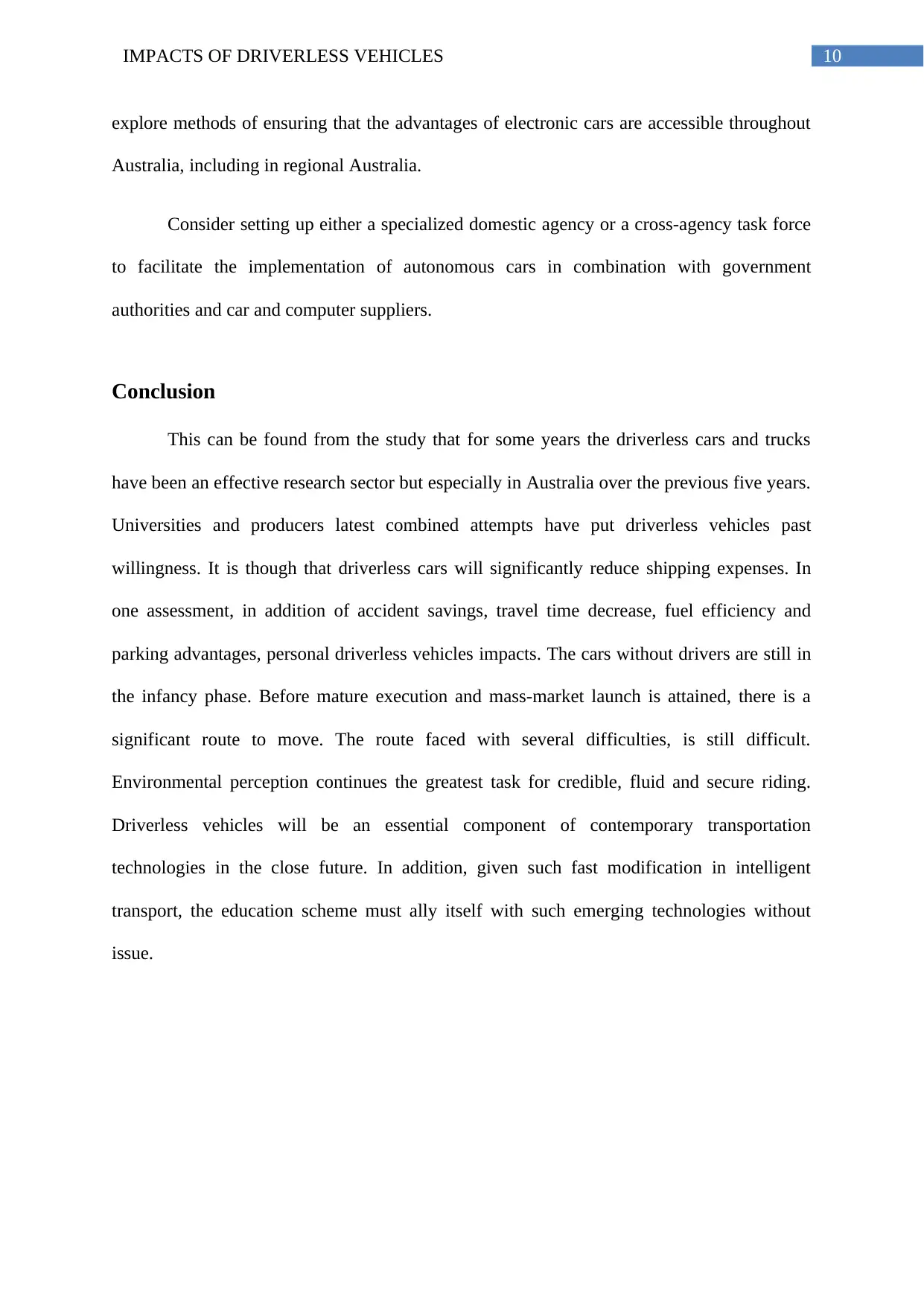
10IMPACTS OF DRIVERLESS VEHICLES
explore methods of ensuring that the advantages of electronic cars are accessible throughout
Australia, including in regional Australia.
Consider setting up either a specialized domestic agency or a cross-agency task force
to facilitate the implementation of autonomous cars in combination with government
authorities and car and computer suppliers.
Conclusion
This can be found from the study that for some years the driverless cars and trucks
have been an effective research sector but especially in Australia over the previous five years.
Universities and producers latest combined attempts have put driverless vehicles past
willingness. It is though that driverless cars will significantly reduce shipping expenses. In
one assessment, in addition of accident savings, travel time decrease, fuel efficiency and
parking advantages, personal driverless vehicles impacts. The cars without drivers are still in
the infancy phase. Before mature execution and mass-market launch is attained, there is a
significant route to move. The route faced with several difficulties, is still difficult.
Environmental perception continues the greatest task for credible, fluid and secure riding.
Driverless vehicles will be an essential component of contemporary transportation
technologies in the close future. In addition, given such fast modification in intelligent
transport, the education scheme must ally itself with such emerging technologies without
issue.
explore methods of ensuring that the advantages of electronic cars are accessible throughout
Australia, including in regional Australia.
Consider setting up either a specialized domestic agency or a cross-agency task force
to facilitate the implementation of autonomous cars in combination with government
authorities and car and computer suppliers.
Conclusion
This can be found from the study that for some years the driverless cars and trucks
have been an effective research sector but especially in Australia over the previous five years.
Universities and producers latest combined attempts have put driverless vehicles past
willingness. It is though that driverless cars will significantly reduce shipping expenses. In
one assessment, in addition of accident savings, travel time decrease, fuel efficiency and
parking advantages, personal driverless vehicles impacts. The cars without drivers are still in
the infancy phase. Before mature execution and mass-market launch is attained, there is a
significant route to move. The route faced with several difficulties, is still difficult.
Environmental perception continues the greatest task for credible, fluid and secure riding.
Driverless vehicles will be an essential component of contemporary transportation
technologies in the close future. In addition, given such fast modification in intelligent
transport, the education scheme must ally itself with such emerging technologies without
issue.
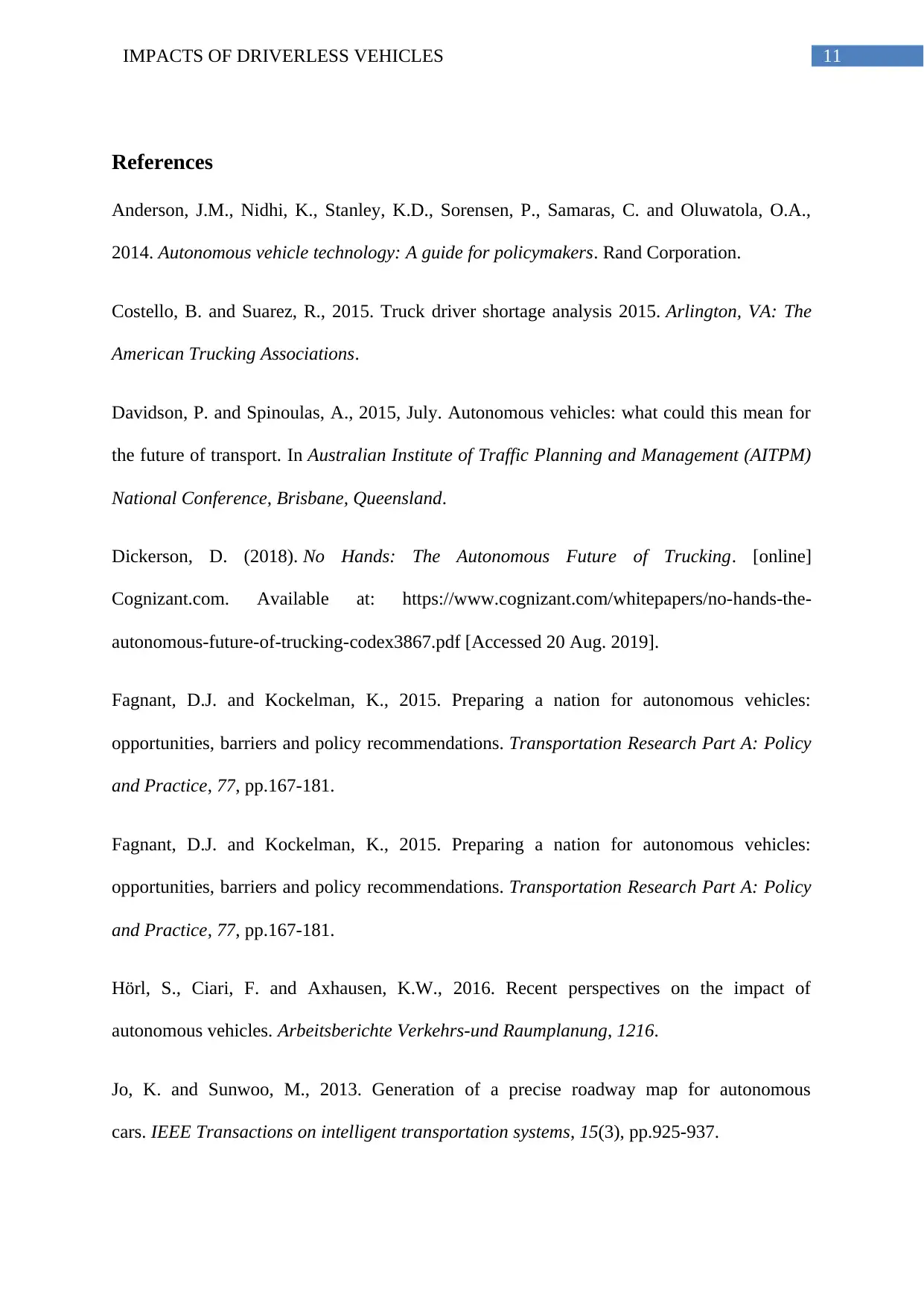
11IMPACTS OF DRIVERLESS VEHICLES
References
Anderson, J.M., Nidhi, K., Stanley, K.D., Sorensen, P., Samaras, C. and Oluwatola, O.A.,
2014. Autonomous vehicle technology: A guide for policymakers. Rand Corporation.
Costello, B. and Suarez, R., 2015. Truck driver shortage analysis 2015. Arlington, VA: The
American Trucking Associations.
Davidson, P. and Spinoulas, A., 2015, July. Autonomous vehicles: what could this mean for
the future of transport. In Australian Institute of Traffic Planning and Management (AITPM)
National Conference, Brisbane, Queensland.
Dickerson, D. (2018). No Hands: The Autonomous Future of Trucking. [online]
Cognizant.com. Available at: https://www.cognizant.com/whitepapers/no-hands-the-
autonomous-future-of-trucking-codex3867.pdf [Accessed 20 Aug. 2019].
Fagnant, D.J. and Kockelman, K., 2015. Preparing a nation for autonomous vehicles:
opportunities, barriers and policy recommendations. Transportation Research Part A: Policy
and Practice, 77, pp.167-181.
Fagnant, D.J. and Kockelman, K., 2015. Preparing a nation for autonomous vehicles:
opportunities, barriers and policy recommendations. Transportation Research Part A: Policy
and Practice, 77, pp.167-181.
Hörl, S., Ciari, F. and Axhausen, K.W., 2016. Recent perspectives on the impact of
autonomous vehicles. Arbeitsberichte Verkehrs-und Raumplanung, 1216.
Jo, K. and Sunwoo, M., 2013. Generation of a precise roadway map for autonomous
cars. IEEE Transactions on intelligent transportation systems, 15(3), pp.925-937.
References
Anderson, J.M., Nidhi, K., Stanley, K.D., Sorensen, P., Samaras, C. and Oluwatola, O.A.,
2014. Autonomous vehicle technology: A guide for policymakers. Rand Corporation.
Costello, B. and Suarez, R., 2015. Truck driver shortage analysis 2015. Arlington, VA: The
American Trucking Associations.
Davidson, P. and Spinoulas, A., 2015, July. Autonomous vehicles: what could this mean for
the future of transport. In Australian Institute of Traffic Planning and Management (AITPM)
National Conference, Brisbane, Queensland.
Dickerson, D. (2018). No Hands: The Autonomous Future of Trucking. [online]
Cognizant.com. Available at: https://www.cognizant.com/whitepapers/no-hands-the-
autonomous-future-of-trucking-codex3867.pdf [Accessed 20 Aug. 2019].
Fagnant, D.J. and Kockelman, K., 2015. Preparing a nation for autonomous vehicles:
opportunities, barriers and policy recommendations. Transportation Research Part A: Policy
and Practice, 77, pp.167-181.
Fagnant, D.J. and Kockelman, K., 2015. Preparing a nation for autonomous vehicles:
opportunities, barriers and policy recommendations. Transportation Research Part A: Policy
and Practice, 77, pp.167-181.
Hörl, S., Ciari, F. and Axhausen, K.W., 2016. Recent perspectives on the impact of
autonomous vehicles. Arbeitsberichte Verkehrs-und Raumplanung, 1216.
Jo, K. and Sunwoo, M., 2013. Generation of a precise roadway map for autonomous
cars. IEEE Transactions on intelligent transportation systems, 15(3), pp.925-937.
⊘ This is a preview!⊘
Do you want full access?
Subscribe today to unlock all pages.

Trusted by 1+ million students worldwide
1 out of 13
Related Documents
Your All-in-One AI-Powered Toolkit for Academic Success.
+13062052269
info@desklib.com
Available 24*7 on WhatsApp / Email
![[object Object]](/_next/static/media/star-bottom.7253800d.svg)
Unlock your academic potential
Copyright © 2020–2025 A2Z Services. All Rights Reserved. Developed and managed by ZUCOL.





